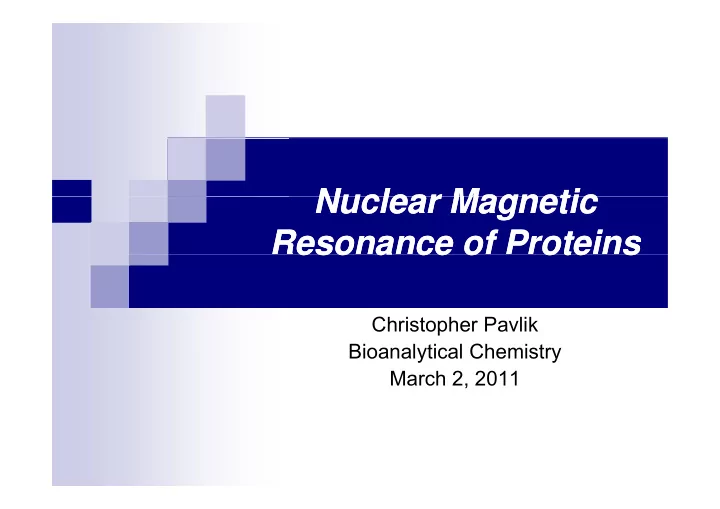

Nuclear Magnetic Nuclear Magnetic Nuclear Magnetic Nuclear Magnetic Resonance of Proteins Resonance of Proteins eso a ce o eso a ce o ote ote s s Christopher Pavlik Bioanalytical Chemistry March 2, 2011
Nuclear Magnetic Resonance “NMR” Application of a magnetic field causes absorption of EM energy that induces absorption of EM energy that induces nuclei to resonate in a specific radio frequency (RF) governed by it surrounding electronic environment Spin ½ nuclei Spin ½ nuclei E 1 >E 2 Boltzman distribution Absorption of the EM causes a temporary orientation of nuclei with the field field Parallel and antiparallel Equilbrium shift with pulses of RF Relaxation causes emission of specific rf
Background Background Original EM source was large Permanent Magnetics 20 Mhz to 60Mhz Movement to Superconducting magnets and increased computation p g g p power revolutionized NMR’s potential Increased computation turnover of complex FID-FT data Exponential increase in peak resolution Great ability to characterization complex molecules 60Mhz 60Mhz 300 Mhz
Shielding and Deshielding Influences on shifts (ppm): Deshielding : due to reduced electron density (Electronegative y ( g atoms) Anisotropy : magnetic field generated by π bonds
1 H-NMR spectra Sample Prep Dissolve in Deuterated Dissolve in Deuterated Solvent Concentration dependent CDCl 3 ; DMSO-d 5 ; 3 5 CD 3 OD; etc Deuteration removes solvent dominance Spin quantum number (l) Spin quantum number (l) of 1 ½ for H Unique splitting (2ln +1)
Protein Crystallography vs Protein NMR Protein Crystallography vs Protein NMR X-ray crystallography Same High resolution Around since early 20 th century A d i l 20 th t Size limitation Si li it ti Accurate, high resolution method 60 kDa monomer, up to 240kDa tetramer 2-3.5 A o 1 Amino acid = 100 Da Requires ability to crystallize protein Measures distances between specific atomic Salting out, Flash Freeze, etc nuclei nuclei No set method for this process No set method for this process 1 H, 2 D, 13 C, 15 N Not all proteins are crystallizable Partial crystals Stable solvent system Long time scale, static structure specific pH, salt conc. Diffraction patterns Solid State Primary structure must be known P i t t t b k S Static and Dynamic structure analysis i d D i l i Specific preparation of protein Growth within an E.coli plasmid 13 C-glucose and 15 NH 4 Cl Primary structure must be known Primary structure must be known
Protein NMR Protein NMR OH O O O Highly complex series of spatial experiments H O N R' 1D NMR identification of small molecules is highly effective R N N H H Supplies very little information of proteins pp y p O O O O 2D, 3D, and 4D NMR experiments alleviates these issues HO NMR strength >300Mhz H 2 N Computing power allowed this to evolve O O methyl cinnamate h l i
2D experiments Revolutionized NMR spectroscopy Provides an ability to analyze the complex structures of highly chiral small molecules t t f hi hl hi l ll l l and also proteins Essentially a stacking of many 1D spectra taken from different spin-frequency p q y coupling states Topographically representation Many different experiments available Simplest is 2D COSY Homonuclear correlation spectroscopy
Time Lapse 2D NOESY Time-Lapse 2D NOESY Deuteration of Protein Nuclear Overhauser effect Exchangeable protons ie: N-H, O-H, COO-H E h bl t i N H O H COO H Unfold, Fold, Exchange Use: NaOD, D 2 O; Heat/D 2 O Cross peaks arise from resonances of protons which are within 5A o . Proximity in Space
Cross peaks indicate that a proton at p p 7ppm is within5A o of the observed H at 3ppm
2D-Arg-H(N)H a H b 3D TOCSY-NOESY 3D HCCH-TOCSY 3D-C b C a CON(H) Torsion Angle 3D-NOESY-HSQC 3D-TOCSY-HSQC
ssMAS NMR Solid State Magic Angle Spinning NMR 54 74 0 from magnetic field 54.74 0 from magnetic field DOR ssNMR 30 o and 54.74 o Bisection of both d and f -orbital Solvent Free Samples that cannot dissolve in solution NMR must be analyzed via solid-state NMR ia solid state NMR Membrane/ Transport proteins, aggregates or proteins which cannot be crystallized or dissolved in a solvent in a solvent Similar experiments done to solution-protein NMR
Computation Involvement Simple 2D COSY Simple 2D COSY 2D COSY 2D COSY 1 st Pulse system X 0 45,90,180 X, Y, Z plane Detect Signal 2 nd pulse Opposite angle Opposite angle Detect signal Complexity increases exponentially Most new work to optimize NMR of TOCSY-HSQC proteins is with formulation of new proteins is with formulation of new and more specific pulse sequences to optimize signal to noise ratios
Problems with NMR based Protein Problems with NMR-based Protein Structure Determination Local Motion of substiuents Methyl rotation, ring flipping, etc Spin diffusion Spin diffusion Improper relaxation times can give erroneous data data
Conclusion NMR is an extremely robust and powerful tool to NMR is an extremely robust and powerful tool to analyze not only small molecules but also macromolecules Largest Current NMR spectrometer is 900Mhz Largest Current NMR spectrometer is 900Mhz Allows for analyst of monomeric proteins as large as 60kDa Solvent-NMR and ssMAS NMR provide multiple p p avenues to acquire structural data on all forms of protein Catalytic, Transport, etc.
Recommend
More recommend